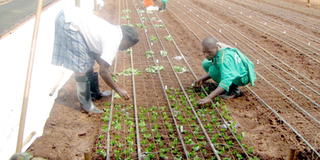
Agriculture employs many Ugandans. file PHOTO
In early 2006, just months before Finance Minister Ezra Suruma read the first budget of a fresh five-year tenure for the National Resistance Movement (NRM) government, two Makerere University students graduated with bachelors’ degrees from Makerere University. The two dreamt of finding employment in sectors where their newly acquired skills would be best utilised. They hoped to secure a future that also would include marriage and a family together.
Four years down the road, few things have gone according to plan. Daniel E. Otabong looked for a job in vain — until last year when, together with some friends, he registered a company that has dabbled with anything from printing, branding, product distribution and IT solutions to events management. The gamble has begun to pay off, with the company earning between Shs2 million and Shs15 million a month.
Mr Otabong’s wife, on the other hand, opted to pursue a masters’ degree after failing to get a job. She has completed it alright, but she remains unemployed.
The mixed fortunes of this young couple mirror those of many educated Ugandans, and provide an insight into formal employment in a country where officials say an average of 400,000 students graduate from tertiary institutions every year only to compete for just 18,000 jobs created in the same period. The inevitable result of this mismatch is that many end up joining the informal sector or having no work to do at all.
Despite the government’s pledge to emphasise programmes designed to stimulate different sectors of the economy to contribute to employment creation, income generation and growth of the economy, the ratio of people joining the labour market has widened compared to the number of jobs created. Much of the spending intended to help create jobs over the last four years has apparently not borne much fruit.
Economy at a crossroads
Today, some 14 per cent of Ugandans who are capable of working are either unemployed or under employed, according to a policy statement issued to Parliament last month by Labour State Minister, Emmanuel Otaala. Of those who have some work to do, 75 per cent are employed in the agriculture sector while 20.7 per cent are in the services sector and 4.2 per cent work in manufacturing.
But even these figures are too positive, according to Finance Minister, Syda Bbumba. Upon launching the budget strategy for 2010/11 on February 26, 2010, she said recent studies have shown that 60 per cent of the labour force perceive themselves as unemployed or under employed, largely because they practice subsistence agriculture. Other studies show that only 5 per cent of the total labour force actually have permanent jobs.
Ms Bbumba acknowledges that the government needs to greatly improve its performance.
With half of Uganda’s population aged 15 years or below, even the 390,000 jobs hitherto required annually are unlikely to be sufficient in the not-so-distant future, as more young Ugandans qualify to enter the labour market.
One of the signs that the government is at a crossroads on how to generate more jobs is a directive issued this month by President Museveni to the Ministry of Public Service to scale down the retirement age from 60 to 50 years, a move officials say would help free up 30,000 public service jobs for the youth.
The move has been interpreted in some quarters as an indication that the government is short of ideas for creating new jobs. The General Secretary of Uganda Government and Allied Workers Union, Irene Kaboole, says: “The government should create jobs, not recycle jobs. Uganda [has] a lot of potential for job creation. Maybe the planning unit has lost direction to lift Uganda up with its natural resources.”
Is agriculture neglected?
Critics believe the trouble, in part, is that the government is paying too little attention to agriculture. In 2006, the government promised that in order to create employment in the agriculture sector from 2006/07 to 2010/11, it would help farmers shift from subsistence production to producing high-value crops for the market. The plan involved identifying these high value crops, improving farming methods and seeds, providing microfinance agricultural loans payable after harvest, establishing cooperatives as marketing agencies, and developing community infrastructure.
The community infrastructure that the government planned to build includes a primary school per parish, electricity, a safe water source, road infrastructure, water for production, a health centre, a community development centre, land for urbanisation, and telecommunications infrastructure.
This plan would, according to the NRM manifesto for 2006, be capped by efforts to process farm goods in Uganda rather than simply exporting them.
“Uganda needs to consolidate private sector, export-led growth and diversification of exportable products through value addition,” the government said. “In order to take advantage of the international markets, Uganda must stop exporting raw and primary materials. Uganda should instead add value to products and export them as finished products.”
However, the ambitious plan was not backed by financial outlays needed for its implementation. An analysis of the budgets shows that rather than growing, spending on agriculture as a percentage of the budget has consistently dropped since 2006. In 2005/06, the government spent 5.7 per cent of the total budget on agriculture, but this fell to 4.1 per cent in 2007/08 and to 3.7 per cent in 2008/09.
Within the same period, the government has paid a lot of attention to the industrial sector. While reading the 2006/07 national budget, Dr Suruma announced that it was embarking on the implementation of the National Industrialisation Policy.
In 2006, government allocated Shs35 billion to the development of Namanve Industrial Park. It also has bought land and set aside billions of shillings for the construction of industrial parks in the districts of Mbarara, Arua, Lira, Gulu, Soroti, Moroto, Mbale, Tororo, Iganga, Jinja, Luwero-Nakaseke, Nakasongola, Bushenyi, Kabale, Kasese, Fort Portal, Hoima, Rakai and Mubende.
In 2007, the government also offered a series of tax incentives to investors engaged in exporting finished consumer and capital goods.
The incentives included a 10-year tax holiday to companies engaged in value-added exports, a withholding tax exemption on interest, raw materials and plant and machinery, a stamp duty exemption on increase in share capital and mortgages, and a duty and tax exemption on raw materials and plant and machinery.
Over the last four years, the government further allocated money to the Makerere University Faculty of Science and Technology, the Industrial Research Centre, and vocational institutions to enable innovate scientists develop commercial technologies. Another beneficiary is the small and medium enterprise sector that can now borrow money guaranteed by the government from the Uganda Development Bank.
In addition, the government is developing the national data transmission backbone across the country to serve telecommunications, banking and other sectors that depend heavily on information technology to thrive.
Troubling Results
Considering the emphasis on industrial development, it may come as no surprise that since the 2005/06 financial year, the contribution of agriculture to Uganda’s Gross Domestic Product (GDP) has fallen from 29 per cent to 21 per cent in 2007/08 and further to 15.1 per cent in 2008/09.
The Executive Director of the Uganda National NGO Forum, Mr Richard Ssewakiryanga, says failure by the government to commit at least 10 per cent of the national budget to agriculture, as agreed by all African governments in the African Union-Maputo Declaration in 2003, contradicts its promise to create jobs.
“Agriculture is the most important source of employment, income and overall well-being,” he said. “The sector is also the basis for much of the industrial activity in Uganda since most industries are agriculture-based.”
“Although the role of agriculture in growth and poverty reduction is well recognised, there has been gross under-investment in the sector over the years. The government has not prioritised agriculture in her policies and spending,” adds Mr Ssewakiryanga.
The shift towards emphasising non-agricultural sectors has paid off to some extent, though not enough to solve Uganda’s employment problems. While agriculture has lost ground, the other two major sectors have increased their contribution to GDP. Currently, according to the latest figures, the services sector leads with 52.8 per cent contribution to GDP while manufacturing accounts for 25.1 per cent. Both have performed better than agriculture.
The improvement in the manufacturing and service sectors reflects improved labour conditions in Uganda due to labour law reforms carried out since 2007. These laws include a new Employment Act, the Trade Unions Act, and the Labour Dispute Act that make working hours more flexible, provide clarity on overtime, and require that the employer notify the labour unions representative and the commissioner in specific dismissal cases.
Still, a 2010 World Bank report, Doing Business, ranked Uganda 112th out of 183 countries for conditions that enhance business activity. Among its neighbours, Uganda performs better than Tanzania (131) but is still worse than Kenya (95) and Rwanda (67).
The World Bank report says Uganda excels in conditions for employment of workers with a global rank of seventh, but this advantage is negated by the poor work ethic of Ugandans as highlighted in the 2009 Africa Competitiveness Report produced by the Africa Development Bank.
According to development analysts, the poor attitude to work is likely to be detrimental to the efforts of many Ugandans to get employment when the East African Common Market is launched on July 1, paving the way for free entry of goods, services and labour within the five countries in the region.
Mr Geoffrey Okoboi, a research fellow with the Economic Policy Research Centre at Makerere University, believes Uganda still has a comparative advantage in the agriculture sector, which it should focus on due to the expected fresh competition for jobs in the manufacturing and service sectors.
“If we want to see real growth in the economy, we have to focus on agriculture. People are moving away not because the sector is bad but because the conditions for them to produce goods are not good. For instance, there is no programme to encourage irrigation in Uganda,” he said.
Juggling act
The Shadow Minister for Finance, Mr Okello Oduman, who provides alternative policy to that of the government in Parliament, also favours allocating a substantial amount of money to the sector that employs the majority of Ugandans.
Mr Oduman argues that planning for employment generation should be phased with agriculture providing a foundation for the development of the other two major sectors whose growth is providing most of the jobs.
“To deal with the employment problems affecting this country, we need to focus on agriculture because that is where the majority of the people are. Instead, people are shifting focus to the service sector and industrialisation, forgetting that transition mechanisms to remove people from the agriculture sector to the service sector and industrialisation have not been put in place. So poor people are locked up in agriculture, and the few people who have gone to school and are able to set up a factory here and there are the only ones able to contribute to economic growth,” said the Bukedea MP (FDC).
Ms Bbumba, however, says all sectors should be propped simultaneously. That would ensure that by the time agriculture is modernised to increase productivity, the country will have established service and industrial sectors for value addition.
“The industrial sector is still under-developed, as Uganda’s export goods are made up of over 95 per cent primary agricultural commodities,” she notes.
“These challenges are compounded by low labour productivity. In addition, other constraints to quality employment include an inappropriate education and training system, inadequate attention to workers training and retraining, low levels of income and savings and inadequate financial intermediation to enable potential entrepreneurs to start new enterprises or expand existing ones.
“Stemming from weaknesses in the education system, little emphasis is placed on entrepreneurship development, vocational training and skills development at all levels. Most of Uganda’s employees have inadequate technical and professional experience about the work being done,” she adds.
Ms Bbumba says in the 2010/11 financial year, the government will allocate funds to enhance the capacity of the food, science and technology department of Makerere University Faculty of Agriculture and the Uganda Industrial Research Institute, invest in more innovative and dynamic vocational training institutions, and establish a small and medium enterprises (SMEs) Entrepreneurs’ Fund. It will provide loans channeled through particular financial institutions at interest rates not exceeding five per cent per annum for a maximum of an eight year term, with a three-year grace period.








